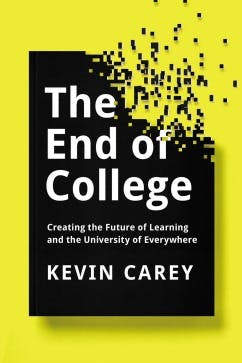On college campuses across America this spring chipper tour guides will bustle high-school seniors and their parents around all the big sites: the dorms, high-tech classrooms, vast libraries, and the flashy new rec centers, with their now-standard lazy rivers and flat-screen TVs. This is closing season, when colleges try to turn “accepted” students into “deposited” ones—admissions-speak for students who have cut their first check to the university. As I shamble professorially between classes, I catch bits of the sales pitch—our library cafe has “great coffee” and the smoothies at the rec center are “amazing.” Fathers in particular tend to look uneasy on these tours, as if what they’d really like to do is check the plumbing. But parents and children alike mostly seem wide-eyed, a bit anxious, and a little bewildered.
No wonder. As Kevin Carey explains in The End of College: Creating the Future of Learning and the University of Everywhere, American universities are strange machines: massive, specialized research operations welded unevenly to undergraduate training programs and semi-professional sports franchises. The credit-hour system that fuels them is a bizarre relic of the same industrial age thinking that gave us punch clocks and assembly lines. Does it really take exactly 120 semester hours to become proficient in English, Psychology, Computer Science, Math, and Leisure Studies?
Carey rightly deplores many gross absurdities of American college today: thousands of boutique classes replicated across the nation, promotion and tenure granted with almost no concern for effective teaching, a generation of students with $1.2 trillion of debt and too few skills. His solution is technology: “The University of Everywhere” will emerge to offer cheap or free classes, skill-based credentials, and unlimited access. He’s surely right that college as we know it is on the cusp of radical change. Just as we no longer need thousands of video rental stores, surely we won’t always use thousands of classrooms, and thousands of professors, to teach essentially the same classes in introductory biology, or algebra, or British Literature.

Carey concedes the problems with early Massive Open Online Courses (MOOCs), especially the astronomically high dropout rates. But the technology continues to improve, and with MOOCs, the self-styled “disrupters” are just getting started. These “disrupters” are the swashbuckling heroes of Carey’s book, men (and they are almost all men) who see “every inconvenience, inefficiency, and injustice as a problem technology can solve.” Take the diploma, for example, which looks good on a wall—if you’re lucky enough to have a wall instead of a cubicle—but which tells a prospective employer almost nothing about your actual skills. Even a detailed transcript offers no real information about the kinds of assignments or range of reading you did in a given class. Or outside of class: Most of us learn just as much in jobs or internships as we do in four years of college. The Mozilla Foundation, which produces the Firefox web browser, has set out to solve this problem by creating “Open Badges,” digital certificates that can include the course you completed, the skills you learned, a portfolio of your work, and the identity of the institution that issued the credential. Open Badges can be easily displayed on websites, and they have been adopted by institutions ranging from the University of Illinois to Codeschool and the Corporation for Public Broadcasting.
If the entrepreneurs in Carey’s book are out to solve real problems, they’re also out to make real money. In one of the most memorable chapters, Michael Staton, a partner at a venture capital fund, shows Carey a chart with circles for various global markets: a small, $300 billion circle for enterprise software, a larger, $1.6 trillion circle for media and entertainment, and a huge, $4.6 trillion circle for education. That’s more than the entire United States budget. Carey likes to describe the venture capitalists out for a slice of this pie as Godzilla-like “thunder lizards,” who destroy “ancient institutions in their last days of decadence” only to plant “seeds of a new world to come.”
But as they circle, might the self-styled thunder lizards be described just as aptly as "vultures"? One of Carey’s chief liberators, for example, is Michael Saylor, “tall and handsome,” a “classic MIT rationalist, someone who sees the world for what it is, and what it should be.” His shady dealings as the CEO of MicroStrategy also led to one of the largest fines in SEC history. The book never asks whether the profit motives of men like Saylor might sit uneasily with the educational mission they proclaim, and this leads to some major problems with its central premise that students and education are being “liberated by technology.”
Technology, in Carey’s world, can do no wrong. Silicon Valley is “a place where people could discard the compromises and confusions of human living and build something more rational and enlightened in their place”; ill-defined advances in “Artificial Intelligence” will someday make it possible for computers to grade and respond to student work just as effectively as humans. A ride in an Uber car prompts Carey to wax poetic about the ways technology transforms lives, liberates individuals, and provides a model for those who want to hack their education. But it provides an even better model of Carey’s tendency to buy the free-market hype peddled by the titans he admires. Uber drivers make about $19 an hour. They provide their own car, insurance, and retirement, without vacation or sick days. The service offers all kinds of efficiencies, but I’m not sure it has solved the problem of systemic injustice, yet.
Carey’s is very much a “great man” theory of history: He likes stories of bootstrapping entrepreneurs, scientists, and reforming college presidents. And many of the educational technologies he describes succeed most dramatically when they help employers or colleges identify unusual geniuses from solitary backwaters—like the 15-year-old Mongolian boy who garnered international attention and a scholarship when he earned a perfect score on a MOOC offered by MIT. Accordingly, Carey uses the telling oxymoron “a typical eighteen-year-old prodigy” to describe the type of student who will benefit from The University of Everywhere.
But the great bulk of education in this country has never been about prodigies. Carey is so eager to focus on the technological solutions, and the prodigies that drive and benefit from them, that he has little time for the mundane realities of higher education. He conflates the issues facing students at community colleges, at for-profit diploma mills, and at expensive tuition-driven universities like George Washington, where would-be diplomats pay $50,000 of tuition and fees per year. (The typical public community college student pays about 5 percent of that.) Such students aren’t behind the student debt bubble, and for many of them, college education won’t make the difference between a shitty food service job and a job cracking the genetic code. But it will make a real difference in their earnings, in their self-conception as citizens, and in their ability to articulate their ideas and aspirations.
As I was writing this article, I spoke with a nontraditional student who has recently returned to school at age 60 to work on her degree. She has no BA, and by most accounts doesn’t need one; in one of life’s beautiful ironies, she’s also recently become the head coordinator of one of the most prestigious graduate programs on our campus. She describes herself as a “life-long learner” who was forced by finances to leave college when younger, only to work her way slowly back into the belly of the beast. But when I suggested she might be an example of why students really don’t need college—or why we might all benefit by putting more courses online—she told me her return to the classroom has nothing with learning job skills. “I stare at my computer all day. Class is where I get away from that. I don’t think any college class has helped me get a job, but going to college has helped me leave one when I started to realize I could do better.” By “do better,” she explained, she was talking about “ethics,” not finances.
Carey does something dangerous by making it sound as if the public institutions built to serve such students are irreparably broken, as if the culprit is simply “decadence,” and as if the sole purpose of college is job placement. He mentions “rising” tuition dozens of times, but never gives any serious thought to the decades of state budget cuts behind that rise. The University of California system, for example, was once the world’s model for public higher education. Then incoming Governor Ronald Reagan announced that taxpayers shouldn’t be “subsidizing intellectual curiosity.” Per capita university funding in California dropped 12 percent between 1984 and 2004, even as spending on prisons grew by 126 percent. After the financial crisis of 2008, the situation worsened across the nation, with 44 of 50 state governments slashing higher education funding. These are the ultimate causes of the student debt crisis.
Universities would be foolish to ignore the promise of new technologies and the imperative of improving access and effectiveness. Some parts of education really are about transmitting information, and by putting them online we could make more time for discussion and mentoring. Some parts of education really are about providing credentials and vocational skills, and we need every tool at our disposal to break down the ivy-covered walls that have limited them to the lucky few. But we would be even more foolish to turn our public and nonprofit universities into a system driven entirely by profits and quantitative outputs. Technologies that allow a few people to achieve greatness are exciting; the work of building and maintaining a system that offers a great many people dignity is often unglamorous, unprofitable, and hard. And on this at least I agree with Carey: It’s time for us to get out of the business of building lazy rivers.
